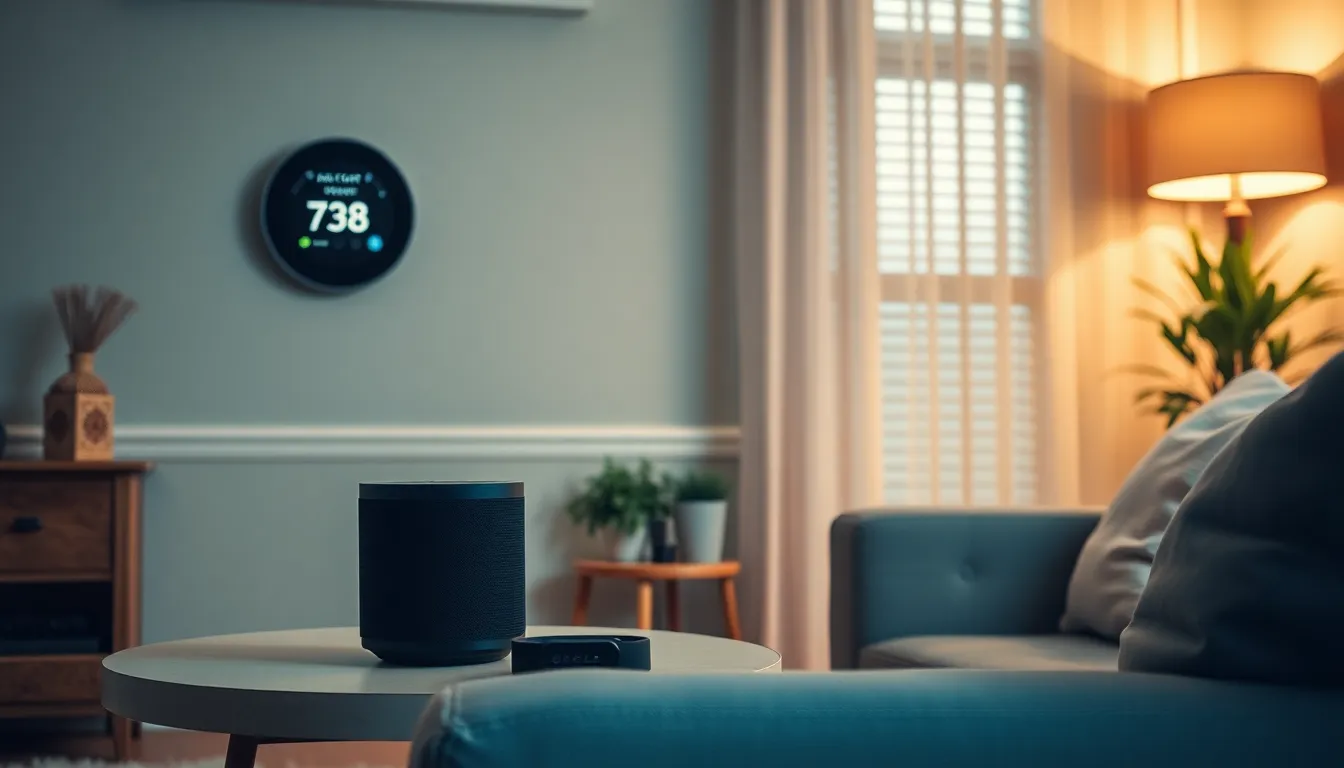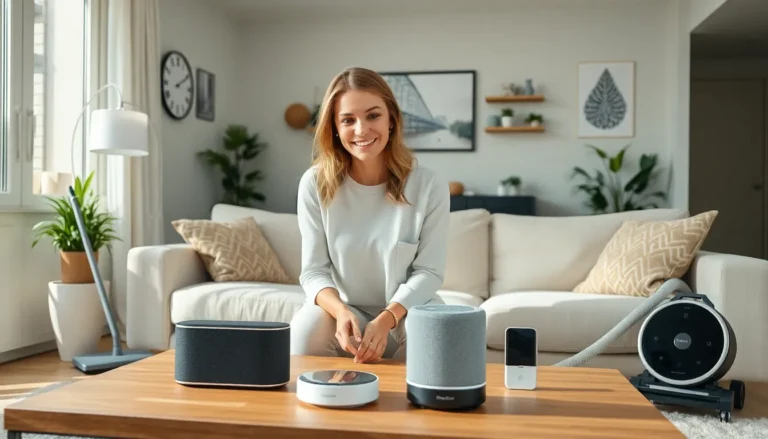In a world where gadgets are getting smarter by the day, AI technology is leading the charge, making life easier and a lot more fun. Imagine a device that not only understands your commands but also predicts your needs before you even know them. Sounds like magic, right? Well, welcome to the age of AI gadgets, where everyday tasks transform into seamless experiences.
Table of Contents
ToggleOverview of AI Gadgets
AI gadgets represent a significant leap in technology, incorporating advanced algorithms and machine learning to enhance user interaction. Devices such as smart speakers, home assistants, and wearables exemplify this trend. Smart speakers, like Amazon Echo and Google Nest, understand voice commands to control music, provide information, and manage household tasks. Home assistants, equipped with AI, personalize responses based on user preferences, creating a more engaging experience.
Wearable technology, including smartwatches and fitness trackers, utilizes AI to monitor health metrics and offer insights for improved well-being. These gadgets analyze data to suggest workouts, track sleep patterns, and provide reminders for hydration or medication. Developers continue integrating AI into everyday devices, increasing convenience for users.
Smart home appliances, including refrigerators and thermostats, enhance efficiency by learning user habits. These appliances adjust settings according to routines, allowing for optimized energy consumption and reducing costs. Imagine a thermostat that lowers the temperature when no one is home and raises it right before the family arrives.
AI in gadgets promotes safety and security. Smart security cameras and video doorbells utilize AI to recognize faces and detect unusual activity, alerting homeowners of potential issues remotely. Each of these advancements suggests a future where AI gadgets not only enhance daily living but also prioritize user comfort and security.
The capability of these gadgets to evolve through updates ensures they remain relevant, adapting to changing user needs. Businesses and consumers alike see immense value in embracing AI technology across various sectors, setting a new standard for innovation and everyday convenience.
Types of AI Gadgets

Various types of AI gadgets enhance everyday life, providing convenience and efficiency across different categories.
Smart Home Devices
Smart home devices include products like thermostats, lights, and security cameras that adapt to user preferences. Many of these gadgets learn from interactions, adjusting settings automatically to improve comfort and energy savings. For instance, devices like the Nest Learning Thermostat can optimize heating and cooling schedules based on user habits. Increased connectivity enables users to control these devices remotely through mobile applications, enhancing convenience and peace of mind. Additionally, they contribute to energy conservation efforts by managing usage intelligently.
Wearable Technology
Wearable technology encompasses gadgets such as smartwatches and fitness trackers that monitor health metrics continuously. These devices collect data on heart rate, activity levels, and sleep patterns to provide users with tailored insights for better lifestyle choices. Popular options like the Apple Watch not only track fitness goals but also offer notifications and connectivity. Users gain motivation and accountability through the metrics these wearables present. These advancements in personal health management empower individuals to take proactive steps towards enhancing overall well-being.
AI-Driven Personal Assistants
AI-driven personal assistants include devices like Amazon Echo and Google Nest Hub, revolutionizing how users interact with technology. These gadgets respond to voice commands, control smart home devices, and provide updates on the weather or news. User-friendly interfaces and adaptive learning capabilities make them particularly intuitive. Some models even integrate with calendars to manage appointments and reminders seamlessly. By offering personalized responses based on user preferences, these assistants streamline daily tasks, making life more efficient and organized.
Benefits of Using AI Gadgets
AI gadgets bring significant advantages that enhance daily living. They streamline tasks, improve convenience, and adapt to user needs seamlessly.
Enhanced Efficiency
Automation plays a key role in enhancing efficiency. Smart home devices adjust settings based on user habits, significantly reducing energy consumption. Scheduling tasks via AI-driven personal assistants saves time, allowing users to focus on more important activities. Wearable technology tracks health metrics automatically, providing users with real-time insights into their fitness without manual input. By learning preferences over time, these gadgets optimize performance, ensuring processes run smoothly and effectively. Productivity increases as users spend less time on repetitive tasks.
Improved User Experience
AI gadgets create a more personalized user experience. Smart speakers respond to voice commands with accuracy, making interactions feel intuitive. Devices like fitness trackers offer tailored recommendations, encouraging users to engage in activities that suit their individual goals. Home assistants provide timely reminders and suggestions based on prior interactions, fostering a sense of companionship. Predictive capabilities of AI enable gadgets to anticipate user needs, enhancing satisfaction with technology. The combination of user-friendly design and intelligent features leads to a seamless integration of technology into daily routines.
Challenges and Considerations
AI gadgets pose unique challenges, especially regarding user privacy and cost. Understanding these considerations ensures smarter and safer choices.
Privacy Concerns
Privacy remains a major issue with AI gadgets. Many devices collect user data to improve functionality, leading to concerns about data security and unauthorized access. Personal information, including voice recordings and usage patterns, can be vulnerable. Consumers often hesitate to fully embrace these technologies due to fears of data breaches. Moreover, developers must implement strong encryption and transparent data policies to protect users. Addressing privacy proactively fosters trust between consumers and manufacturers, encouraging wider adoption.
Cost and Accessibility
The cost of AI gadgets can be a barrier for some users. Advanced technology often translates to higher prices, making these gadgets less accessible to budget-conscious consumers. Affordability plays a crucial role, as many potential users may prioritize essential expenses over smart technologies. While some devices offer lower-cost alternatives, they might lack essential features. Grants and initiatives from organizations can help bridge the gap, making AI technology available to broader audiences. By ensuring affordability, manufacturers can increase market reach and user engagement.
Future Trends in AI Gadgets
Emerging AI gadgets are set to transform everyday experiences. Enhanced personalization features prepare devices to respond more accurately to individual user preferences. Increasingly sophisticated algorithms enable smart speakers and personal assistants to improve their understanding over time.
Home automation will see significant advancements. More devices are integrating seamlessly into smart home ecosystems, allowing for centralized control. This interconnectedness enhances user convenience and energy efficiency, adapting settings to optimize performance.
Wearable technology continues to evolve significantly. Innovations in sensors and data analytics empower devices to offer real-time health monitoring. Many gadgets provide alerts for irregular activity, supporting proactive health management.
Security features will also gain prominence in AI gadgets. Devices that recognize user patterns will contribute to more secure environments. With face recognition and behavior analysis, users can experience heightened safety in their homes and workplaces.
Expect advancements in energy conservation strategies. AI-driven gadgets will learn energy consumption patterns, suggesting optimal usage times. Tools that automate energy reduction efforts help users save both money and resources.
Affordability remains a crucial factor for broader adoption. Manufacturers are working on cost-effective solutions to make AI gadgets more accessible. As competition increases, prices are expected to stabilize, encouraging consumers to embrace these technologies.
Privacy considerations will remain a priority. Developers are focused on creating transparent data policies that protect user information. Robust encryption methods aim to reassure consumers about the security of their data.
Overall, the landscape of AI gadgets is rapidly evolving. Surging advancements promise improved user experiences across all sectors. The combined efforts toward personalization, security, and affordability highlight the future potential of AI technology in everyday life.
The evolution of AI gadgets is reshaping how individuals interact with technology in their daily lives. These devices not only enhance convenience but also prioritize user comfort and security. As advancements continue to unfold, the integration of AI into everyday tools promises a more intuitive experience.
While challenges like privacy concerns and cost remain, ongoing innovations and a focus on affordability will likely encourage wider adoption. The future of AI gadgets looks bright as they become increasingly personalized and efficient, paving the way for smarter living environments. Embracing these technologies can lead to improved productivity and satisfaction, making them an essential part of modern life.



